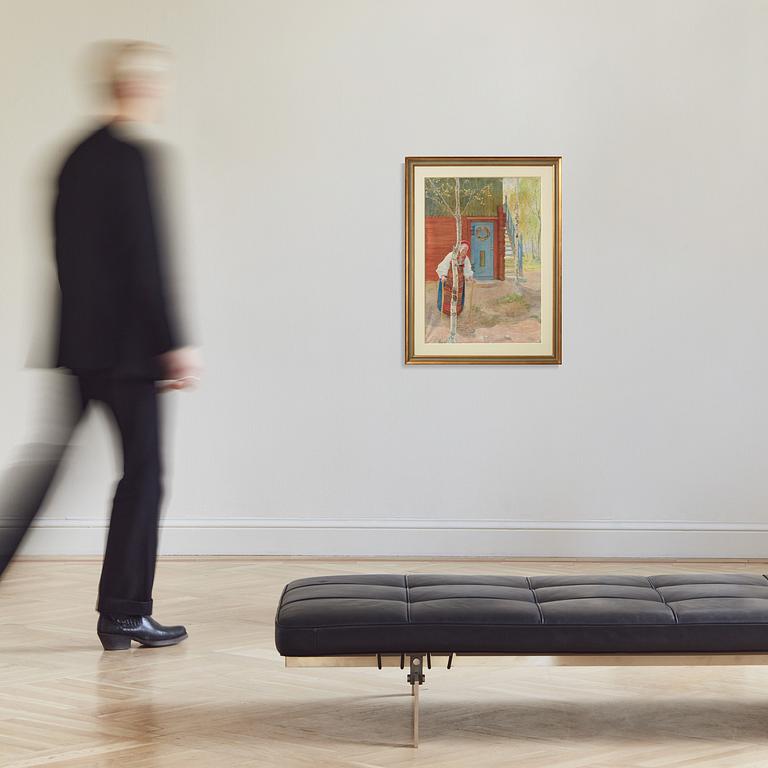Carl Larsson
"Gumman i Maj månad"
Signed C.L. within a circle and dated 1907. Watercolour 73 x 51 cm.
Alkuperä - Provenienssi
Bukowski Auktioner AB, auktion 405, Höstauktionen, 1 - 4 November 1977, cat. no 452.
Näyttelyt
Barnens Dags Konstutställning i Falun, 30 May - 10 June, 1908; Konstföreningens för södra Sverige Carl Larsson-utställning, Malmö, June - July 1910, cat. no 84; Liljevalchs konsthall, Stockholm, "Minnesutställning Carl Larsson", 6 March - 5 April 1920, cat. no 227.
Liljevalchs konsthall, Stockholm, "Carl Larsson, minnesutställning" 1953, except cat. (then owned by L. Yngström).
Kirjallisuus
Ulwa Neergaard, "Carl Larsson. Signerat med pensel och penna", 1999, listed in the catalog supplement under year 1907, p. 112 as no 1233.
Muut tiedot
Carl Larsson bought the farm Spadarvet in Sundborn parish in 1897 and is now listed in the priest's certificate as "artist and farmer". Spadarvet was the neighboring farm to Lilla Hyttnäs in Sundborn where Carl Larsson lived. He bought the farm and let the couple, Johan and Johanna, farm for him and his growing family. The purchase, which was partly financed by the income from the National Museum frescoes, included the cottage Kartbacken where Carl Larsson's parents moved in. A romantic dream from his youth was fulfilled and for Carl Larsson the acquisition of Spadarvet had a symbolic meaning.
The flight from the countryside to the cities and emigration to America had provoked a counter-movement of romanticizing the old peasant society. Artists and poets, who had returned to Sweden after a few years on the continent, sought to leave the cities for nature. In Stockholm, this romanticism found expression in Skansen, founded in 1891 by Arthur Hazelius. Carl Larsson's attitude to the rapid development of modern society became increasingly conservative and he stated that the peasant culture represented the firm foundation of society and from the soil the national strength should be drawn. The watercolor series 'Spadarvet - mitt lilla lantbruk', published in 1906, celebrates the work of the Swedish farmer.
In the watercolor "Gumman i Maj månad", we see the elderly Kersti Kvarnberg, often called Mother Kersti, using her cane to make her way through the courtyard in front of the combined brewhouse and bakery at Spadarvet. Mother Kersti lived at Spadarvet and is often depicted in her Boda costume. The red color of the apron harmonizes with the falu red brewhouse. The complementary blue color in the details of her dress is repeated in the staircase railing and in the blue door decorated with a flower wreath framing the text "Färdig Suzanne-Dagen 1906". Mother Kersti appears in several of Carl Larsson's works, including "Nu är det jul igen" from 1906, where Mother Kersti is in the foreground, sitting on the edge of the fireplace. In "Frukost i det gröna" from 1910-1913, she makes her way through the birch trees with the help of her two canes. In the watercolor "Mor Kersti / Mitt nordiska museum" from 1910, published in "Åt solsidan", we meet her as she laboriously climbs to the second floor of the Spadarvet manor house. In the auction painting, Mother Kersti looks out from behind the birch tree trunk with an alert and interested gaze. Her posture reflects the shape of the tree. Mother Kersti was an important part of life at Spadarvet, in harmony with nature.





































































